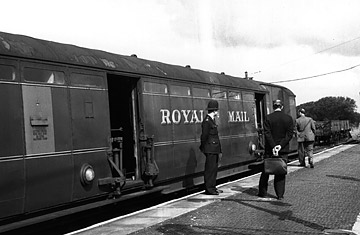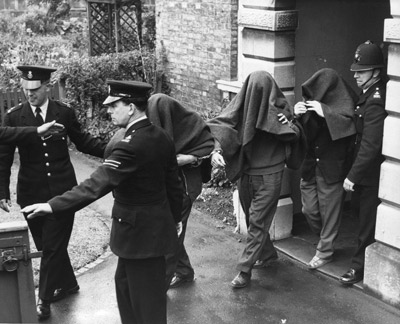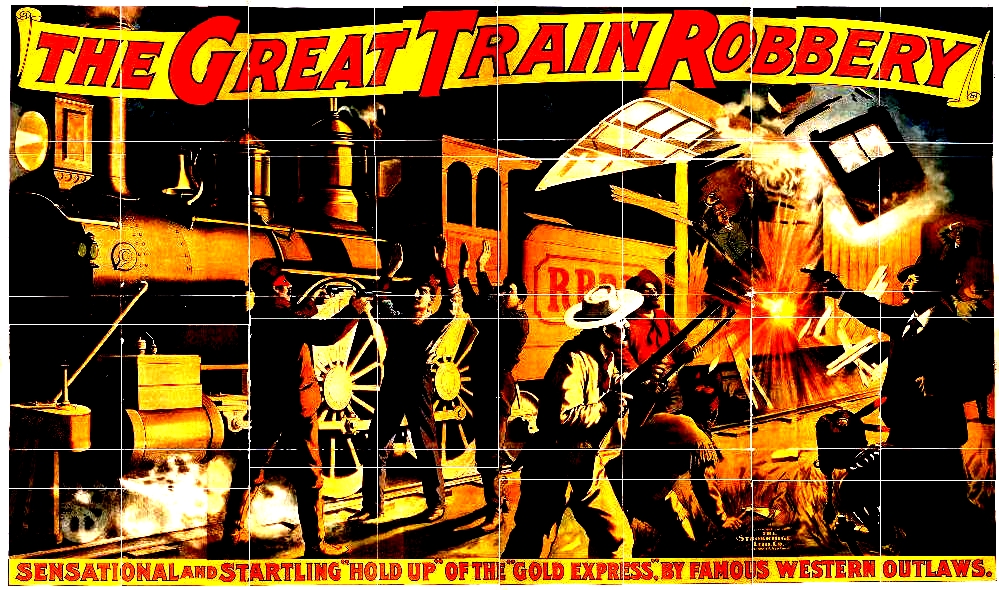
|
|||
The Great Train Robbery - Unsolved Mystery
Source : http://en.wikipedia.org/wiki/Great_Train_Robbery_%281963%29
The Great Train Robbery is the name given to a £2.6 million train robbery (the equivalent of £41 million today) committed on 8 August 1963 at Bridego Railway Bridge, Ledburn near Mentmore in Buckinghamshire, England. The bulk of the stolen money was not recovered. Three robbers were never found, two convicted robbers escaped. One convicted was most likely never involved, and died in prison. Though there were no firearms involved, the standard judgment was 30 years. Planning the robbery The robbery was planned by several parties with no overall mastermind. Although the robbery operation itself was planned and executed by the late Bruce Reynolds, the target and the information came from a still unknown individual dubbed the "Ulsterman". The key field organisers were Gordon Goody, Buster Edwards and Charlie Wilson, with Brian Field being the key link between the robbers and the informant. At 6:50 PM on Wednesday 7 August 1963 the travelling post office (TPO) "Up Special" train set off from Glasgow Central Station, Scotland en route to Euston Station in London. The train was hauled by an English Electric Type 4 (later Class 40) diesel-electric locomotive numbered at the time as D326 (later renumbered 40 126). The train consisted of 12 carriages and carried 72 Post Office staff who sorted mail during the journey. Mail was loaded onto the train at Glasgow and also during station stops en route, as well as from line-side collection points where local post office staff would hang mail sacks on elevated track-side hooks which were caught by nets deployed by the on-board staff. Sorted mail on the train could also be dropped off at the same time. This process of exchange allowed mail to be distributed locally without delaying the train with unnecessary station stops. One of the carriages involved in the robbery is preserved at the Severn Valley Railway. The second carriage behind the engine was known as the HVP (High Value Packages) coach, which carried large quantities of money, as well as registered mail for sorting. Usually the value of the shipment was in the region of £300,000, but because there had been a Bank Holiday weekend in Scotland, the total on the day of the robbery was £2.6 million (equivalent to about £43 million in 2012 RPI terms). Stopping the train Just after 3 AM the driver, Jack Mills from Crewe, stopped the train on West Coast Main Line at a red signal light in Ledburn, at a place known as 'Sears Crossing', between Leighton Buzzard in Bedfordshire and Cheddington in Buckinghamshire. However, unknown to him, the signal equipment had been tampered with by the robbers. They had covered the green signal light and connected a six-volt Ever Ready battery to power the red signal light. The locomotive's second crew-member, known as the secondman, was 26-year-old David Whitby (also from Crewe). He climbed down from the cab to call the signalman from a railway track-side telephone, only to find the cables had been cut. Returning to the train, he was thrown down the embankment of the railway track by one of the robbers.  The robbers now encountered a problem. They had to move the train to a suitable location in order to load their ex-army dropside truck with the stolen money and had decided to do so at bridge No.127 (known as 'Bridego Bridge'), approximately half a mile (800m) further along the track. One of the robbers had spent months befriending railway staff and familiarising himself with the layout and operation, but it was decided that it would be better to use an experienced train driver to move the train from the signals to the bridge after uncoupling the carriages containing the rest of the sorters and the ordinary mail. However, the person they selected (later referred to as "Stan Agate") was unable to operate the English Electric Class 40 mainline diesel-electric locomotive, because he was only experienced with shunting (switching) type locomotives on the Southern Region. It was quickly decided that the original locomotive driver, Jack Mills, should move the train to the stopping point near the bridge, which was indicated by a white sheet stretched between poles on the track. Mills was initially reluctant to move the train so one of the gang struck him on the head. Since Ronnie Biggs' only task was to supervise "Stan Agate's" participation in the robbery, when it became obvious that Stan was not needed to drive the train, he and Ronnie were banished to the waiting truck to help load the mail bags.
The getaway and the clean up The gang then headed along back roads listening for police broadcasts on a VHF radio and arrived at Leatherslade Farm, a run-down farm 27 miles (43 km) from the crime scene, situated between Oakley and Brill in Buckinghamshire . The farm had been bought two months earlier for use as their hideout. At the farm they counted the proceeds of the robbery and divided it into 17 full shares and several 'drinks' (smaller sums of money intended for associates of the gang). The precise amounts of the split differ according to the source, but the full shares came to approximately £150,000 each. It quickly became apparent that the police believed that the robbers had stayed in the area rather than scattered with their haul, so the gang's plan for leaving the farm was brought forward to Friday instead of Sunday. The vehicles they had driven to the farm could no longer be used because they had been seen by the train staff. Brian Field came to the farm on Thursday to pick up his share of the loot and to take Roy James to London to find an extra vehicle. Bruce Reynolds and John Daly picked up cars, one for Jimmy White and the other for Reynolds, Daly, Biggs and the replacement train driver. Field, his wife Karin and his associate "Mark" brought the vans and drove the remainder of the gang to 'Kabri' to recover. Field had arranged with "Mark" to carry out a comprehensive clean-up of the farm after the robbers had left, even though the robbers had already spent much time wiping the place down to be free of prints. According to Buster Edwards, he 'nicked' £10,000 in ten-shilling notes to help pay "Mark's" drink. However, on Monday, when Charlie Wilson rang Brian Field to check whether the farm had been cleaned, he did not believe Field's assurances. He called a meeting with Edwards, Reynolds, Daly and James and they agreed that they needed to be sure. They called Field to a meeting on Tuesday, where he was forced to admit that he could not be sure that the farm had been cleaned. Wilson would have killed him there and then but was restrained by the others. By the time they were ready to go back to the farm, however, they learned that police had found the hide-out. The loot £2,631,684 was stolen from the train. The bulk of the haul was in £1 notes and £5 notes (both the older white note and the newer blue note, which was half its size). There were also ten-shilling notes and Irish and Scottish money. Because time was limited by professional standard, 8 out of 126 bags were not stolen. Statistically, this could be £131,000 or 4.7% left behind. Raising the alarm The robbers had cut all the telephone lines in the vicinity, but one of the trainmen caught a slow train to Cheddington, which he reached at 4:30 a.m. to raise the alarm The Great Train Robbery Investigation Just two days after the robbery, the Flying Squad was created from the best detectives of Scotland Yard and was charged with finding the criminals behind the Great Train Robbery. Detective Chief Superintendent Tommy Butler, known around Scotland Yard for his professionalism and thoroughness, was assigned to be the squad's chief. Among the team of detectives was Jack Slipper, a tall man with a pencil moustache who would become a household name for his work on the case and his cat-and-mouse chases with Ronnie Biggs. The Flying Squad's first break in the case came eight days after its investigation began. A suspicious vehicle was reported at an old farmhouse about 30 miles (48.28 km) from the scene of the crime. The old farmhouse -- Leatherslade Farm -- was the same one that the men used as their safe house. Food, sleeping bags and bedding were found in the house, along with bank note wrappers and post office sacks. Fingerprints were found on a bottle of ketchup and on the Monopoly game the men had played with some of the £1, £5 and £10 notes they had stolen. Within a day of the discovery of the fingerprints, Roger Cordrey was arrested. In a week, Charlie Wilson was arrested in London and police were on to Bruce Reynolds, Jimmy White, Roy James and Buster Edwards. Biggs' fingerprint was found on a bottle of ketchup in the safe house and he was arrested on Sept. 4, 1963. Ronnie Biggs, Charlie Wilson, Tommy Wisbey, Jim Hussey and Bob Welch were all sent to Bedford prison to await trial. While in prison, they learned that Goody had been questioned but let go for insufficient evidence. However, several weeks later, he, too, was arrested, charged and sent to Bedford. Three of the suspects arrested in connection with the Great Train Robbery are photographed leaving Linslade court with blankets over their heads.  Two months after arriving at Bedford, Biggs was planning his escape but would have to wait -- the group was transferred to Aylesbury prison and security was tight. During their time at Aylesbury, they learned evidence against them was strong and Biggs again began to plot escape. But he was foiled when one of his friends got cold feet. By December of that year, John Wheater, Brian Fields, John Daly and Roy James were arrested -- James in a spectacular chase across neighborhood rooftops before his capture. Bruce Reynolds evaded arrest until 1969. Twelve of the 15 robbers were eventually caught and brought to trial. But how were they sentenced, and did any escape? Find out in the next section. The Great Train Robbery Trial and Aftermath Because the gang had planned to escape the Aylesbury prison, they were watched closely until their trial began. On Jan. 20, 1964, they appeared before Justice Edmund Davies at Buckinghamshire Assizes. Ronnie Biggs, Tommy Wisbey, Charlie Wilson, Roy James, Bob Welch, Gordon Goody, Leonard Field, Brian Field, William Boal, and John Wheater all plead not guilty. Roger Cordrey was the only man to plead guilty and gave back his share of the money -- £80,000. Two weeks into the trial, evidence surfaced that showed Biggs had a criminal record. Fearing this could sway the jury, the judge halted the trial and ordered Biggs to stand trial at a later date. The trial went on for months and included testimony from bank officials and the train driver, Jack Mills, who took the stand and told the story of the robbery and the injury so severe he wasn't able to continue working. John Daly, who was implicated because his fingerprints were found on the Monopoly game, was acquitted during the defense proceedings in March 1964. His lawyer petitioned that the fingerprints could have been on the game prior to it being at the farm. On March 25, 1964, the jury found all of the accused guilty of conspiracy to rob, and Tom Wisbey, Roy James, Charlie Wilson, Bob Welch, Jim Hussey and Gordon Goody were found guilty of robbery with violence. Sentencing wouldn't be set down until Biggs' retrial, however, which was scheduled for April 8, 1964. His retrial only took seven days, and the jury swiftly found him guilty. On April 16, 1964, sentences were handed out by Justice Davies, who was heavy-handed due to the violence against Jack Mills. The men received 30 years apiece with few exceptions. John Wheater, who arranged the safe house, received three years; Roger Cordrey received 20 years; William Boal received 24 and Brian and Leonard Field each received 25. After appeals, Cordrey and Boal's sentences were reduced to 14 years each, and Brian and Leonard Field each had their sentences reduced to five years. Buster Edwards, Bruce Reynolds and Jimmy White were all found and jailed by 1969. Edwards fled to Mexico but turned himself in three years after the crime. After five years on the run, the mastermind Reynolds was captured and sentenced to 10 years in prison. The robbers were placed in prisons across the country, and in August 1964, Charlie Wilson, incarcerated in Winson Green maximum-security prison, was the first of the gang to escape. He was recaptured in 1968. Biggs was sent to Wandsworth prison -- Britain's version of Alcatraz. Only 15 months after arriving at Wandsworth, Biggs escaped in a furniture van and became Britain's most notorious fugitive. He underwent plastic surgery to disguise his face and fled to Australia and eventually Brazil, where, in 1970, he settled in as "Michael Haynes." Biggs evaded return to the U.K. for more than three decades amidst attempts to extradite him: Once in 1974 when Slipper showed up at his door, and again in 1981 with a kidnapping attempt by British ex-military. In 2001, an ailing Biggs, the man who had almost gotten away with it, voluntarily returned to the U.K. to serve the remaining 28 years of his sentence in a Norwich jail for elderly inmates. He outlives his rival, Jack Slipper, who passed away in 2005. Submit News/Videos/Links | Discuss article | Article Link | More Unsolved and Unexplained Mysteries |
More can be addded on request. Direct your requests at vinit@theunexplainedmysteries.com
